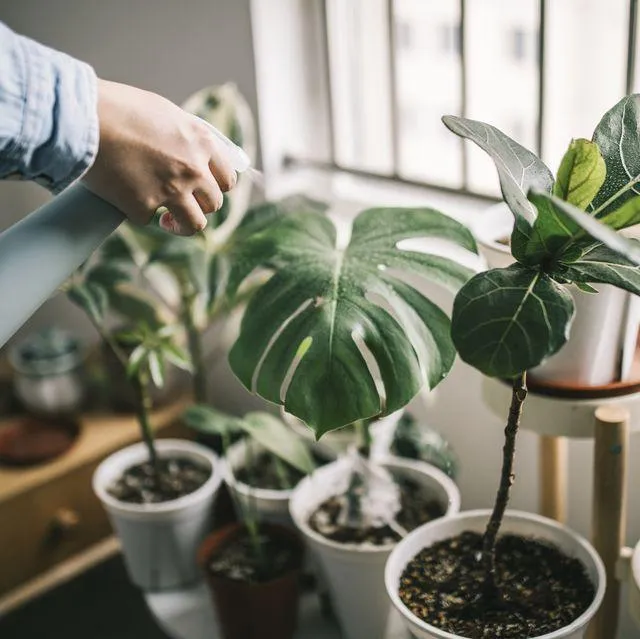The Coolest Indoor Trees to Brighten Up Your Home
If you’re looking to add a touch of natural beauty and greenery to your indoor spaces, houseplants are a great option. But not all houseplants are created equal – some are easier to care for than others. In this article, I’ll discuss some of the coolest and most attractive indoor tree options that will thrive in your home.
Chinese Evergreen (Aglaonema)
- One of the most popular and low-maintenance indoor trees is the Chinese evergreen. From my experience keeping many houseplants, these trees are very forgiving and almost impossible to kill. They do well in low to medium light and prefer consistent moisture in the soil.
- With their colorful leaves ranging from dark green to pink, white, and variegated patterns, Chinese evergreens add instant beauty. They come in compact sizes perfect for tables or as tall standing trees. I’ve seen these trees survive total neglect for months!
- Just water when the top inch of soil feels dry and you’ll have an attractive houseplant that requires very little care. Chinese evergreens are definitely one of the “coolest” indoor trees for beginners.
Dwarf Umbrella Tree (Schefflera arboricola)
- Another excellent low-maintenance tree choice is the dwarf umbrella tree. As the name hints, its leaves resemble tiny opened umbrellas clustered together.
- These trees tolerate wide ranges of light and moisture levels. I keep mine in medium light and allow the top inch of soil to dry slightly between waterings. Umbrella trees can grow 5-6 feet tall indoors but dwarf varieties stay below 4 feet, making them a great size for homes.
- Their texture and rounded shapes add visual interest to any room. Plus, umbrella trees are very hardy – I’ve yet to experience one dying on me like less resilient houseplants. For a reliable indoor tree that’s fairly trouble-free, you can’t go wrong with a dwarf umbrella tree.
Dwarf Date Palm (Phoenix roebelenii)
- For a truly “tropical” indoor tree look, consider dwarf date palms. While full-size date palms require warmth, their miniature cousins adapt well to indoor conditions. I keep mine in bright, indirect light near a south-facing window.
- These palms stay under 5 feet and have a neat, compact frond pattern that resembles adult date palms. Dwarf date palms actually prefer slightly drier soil than other houseplants – just water when the top inches start to feel dry.
- With their exotic palm appearance, these trees provide a tropical flair indoors. In my opinion, nothing quite beats dwarf date palms for an indoor “tree” you can enjoy year-round without a greenhouse. Just don’t overwater the roots.
Polyscias (Peace Lily Tree)
- If you want a low-light indoor tree, consider polyscias or “peace lily trees.” These beauties thrive in low and artificial light, making them perfect for darker rooms or offices. I keep one in my kitchen away from direct sun.
- Peace lily trees grow several feet tall indoors and have glossy, deep green leaves. Thankfully, they’re also very forgiving of occasional underwatering – basically you can’t mess these up as they indicate thirst by drooping leaves.
- With their ability to adapt in less-than-ideal conditions, peace lily trees make an excellent low-effort, low-stress indoor tree for low-light areas. Their lush appearance would brighten up any space.
So in summary, from my experience the Chinese evergreen, dwarf umbrella tree, dwarf date palm, and polyscia peace lily tree are some of the easiest and most beautiful indoor tree options. But which one is best overall? It honestly depends on your environment and preferences. Speaking from personal experience maintaining many plants over the years, I can confidently say those four trees represent some of the most “bulletproof” houseplants you’ll find. They add big impact with very little effort.
Now, low-maintenance doesn’t mean these trees are completely hands-off. Here are some additional tips you basically need to know:

Care Basics for All Indoor Trees
- Water when the top 1-2 inches of soil begin to dry out. For most, around once a week should suffice. It’s better to water thoroughly then allow soil to dry than keep constantly moist.
- Mist leaves occasionally if indoor humidity is low to prevent browning. Peace lily trees especially appreciate occasional misting or pebble trays beneath the pot.
- Repot in new soil every 1-2 years in the spring when new growth starts. Pot should allow 1-2 inches of space around outer root ball.
- Fertilize lightly during growing seasons in spring and summer. Follow label instructions carefully to avoid burning the sensitive roots.
- Prune tangled or damaged growth and trim as desired to keep a pleasing shape. Cut stems 1/4 inch above a leaf joint or node.
While these trees are low maintenance, issues can still arise if care demands aren’t met. From my own mistakes, I’ve learned brown or yellowed leaves usually mean too much water, not enough light, fertilizer burn, or pests. White spots could indicate mineral buildup from hard water.
But in most cases, if you follow the basic watering, pruning, and care outlined above for your specific tree type, you’ll have an indoor tree friend for many years! So which one will bring nature indoors for you – the stately Chinese evergreen, umbrella tree, palm tree flair, or low-light loving peace lily? Let me know if you have any other tree care questions!
Indoor Trees For Your Home

| Tree | Size | Care Level | Water Needs |
|---|---|---|---|
| ZZ Plant | Medium | Low | Allow soil to dry slightly between waterings |
| Chinese Evergreen | Large | Medium | Water when top 1 inch of soil is dry |
| Peace Lily | Small | Low | Keep soil moist at all times |
| Snake Plant | Tall | Low | Water every few weeks |
| English Ivy | Vining | Low | Mist foliage regularly, water soil when dry |
FAQ
-
What are some of the coolest indoor trees to have?
Some of the best indoor trees are the Chinese Money Plant, Snake Plant, and Peace Lily. The Chinese Money Plant has interesting coin-shaped leaves and is kind of easy to take care of. The Snake Plant thrives even with little care. Peace Lilies are amazing plants that can brighten up any room with their pretty white flowers.
-
How do I care for indoor trees?
Indoor trees require correct watering and moderate light. You need to water them when the soil is dry, but be careful not to overwater. They like bright spots, but no direct sun. At the same time, they can tolerate lower light. Fertilizing every few months helps them stay healthy. Cleaning the leaves occasionally gets rid of dust. All in all, indoor trees are forgiving plants that don’t take much work.
-
Are there any indoor trees that are toxic to pets?
Unfortunately yeah, there are a few that can cause issues for furry friends. The Chinese Evergreen is potentially poisonous if cats or dogs chew on it. Same goes for the Dumb Cane plant – it contains calcium oxalate crystals that can irritate skin and mouths. Always do your research before bringing new plants home if you have pets. Their safety should come first!

-
What is the easiest indoor tree to grow?
Most experts say the Snake Plant and Pothos are basically the lowest maintenance indoor trees. They are super hardy and don’t need much light or water to survive. The Snake Plant can go weeks without a drink! Pothos are very forgiving too. As long as you don’t totally neglect them, these plants will hang in there.
-
How big do indoor trees get?
It depends on the type of tree, but many favorite indoor varieties will max out at a medium size. The Chinese Money Plant and Peace Lily reach only 2-3 feet tall. Meanwhile, the Bamboo Palm can stretch to 6 feet tall – so it’s not suited for tiny spaces. Do your homework on mature sizes to avoid ending up with an indoor “tree” that’s too big for its pot.
-
When should I re-pot my indoor tree?
Most plants will need a larger pot after a year or two of growth. Check the roots through the drainage holes – if they’re circling around the bottom or sides, it’s time for a re-pot. Use a container just 1-2 inches wider than the current root ball. And make sure the new pot has good drainage too, or it could cause root rot. Proper re-potting helps indoor trees stay healthy for many years.

-
Where can indoor trees be purchased?
You can find tons of options at local garden centers, hardware stores, and even some supermarkets. However, a good online plant retailer will offer an amazing selection, including harder to find varieties. Sites like Etsy have great indie plant shops too. You can’t see the trees in person with online orders, but reputable sellers ensure healthy delivery. With a little surfing, the best indoor trees can be shipped right to your door!
-
How do I know if my indoor tree needs help?
Keep an eye out for signs of distress. Wilting or yellowing leaves are never good. Watch for mushroom growth at the base – a sign of overwatering. Check for pests like spider mites or scale too. Drooping stems or curling leaves might mean too much sun or not enough water. If problems arise, a remedy may be needed quickly. Remember – trees that are well cared for will reward you with steady growth and years of enjoyment!
